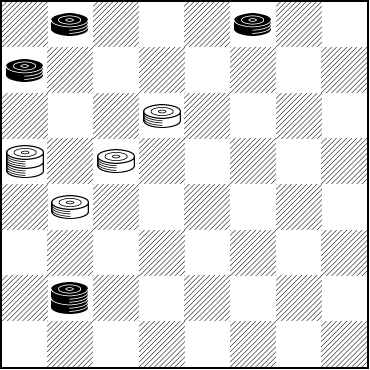The Checker Maven
Jump to navigationThe Teacher Gets an "F"

In today's Checker School column we return to Andrew J. Banks' curious and entertaining book, Checker Board Strategy, and our old friends Skittle and Nemo, who are joined by Stone. It's an example of how not to teach checkers. Let's hear the story in Mr. Banks' own words.
"Solve it yourself!" boomed the gray haired State Champion. By his perennial cheerfulness, Skittle had won friends in the Nation's Capital. His mirth was "like a flash of lightning that breaks through the gloom of clouds." He wished to be a "big shot" in Nemo's eyes; therefore, he had asked Champion Stone to teach him how to play expertly. Stone had set up a tough problem. Skittle was baffled.
"Show me how to solve it," he repeated, whereupon Stone roared, "Solve it yourself!"
Was Stone's method wrong? Yes; he failed to show where and why his pupil had failed--- consequently Skittle was crushed. A teacher must adapt his teaching to the ability and temperament of his student. Moreover, he must proceed from the simple to the complex. Do you not agree?
Indeed, hardly the way to encourage a student of the grand old game. The problem in question was a very old one by William Payne. It won't be hard at all for an experienced player but is a good exercise for the student.

WHITE
White to Play and Win
W:B1,3,5,K25:W10,14,17,K13
We can't really understand why Stone thought this was a hard problem. Be that as it may, an expert will solve it in seconds though a progressing player might take a little longer. We're happy to show you how to solve it; just click on Read More, and we promise that no one will shout at you.![]()
Solution
10-6 1x10 14x7 3x10 17-14 10x17 13x29 5-9 29-25 9-14 25-22 White Wins.
This is an example of a rebound shot, something we've seen before in our Checker Maven columns. It's a technique worth knowing about.
Should this have been a speed problem? Perhaps. But we wanted to present the point that Mr. Banks makes; teachers can fail as well as students.

You can email the Webmaster with comments on this article.
